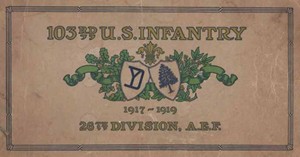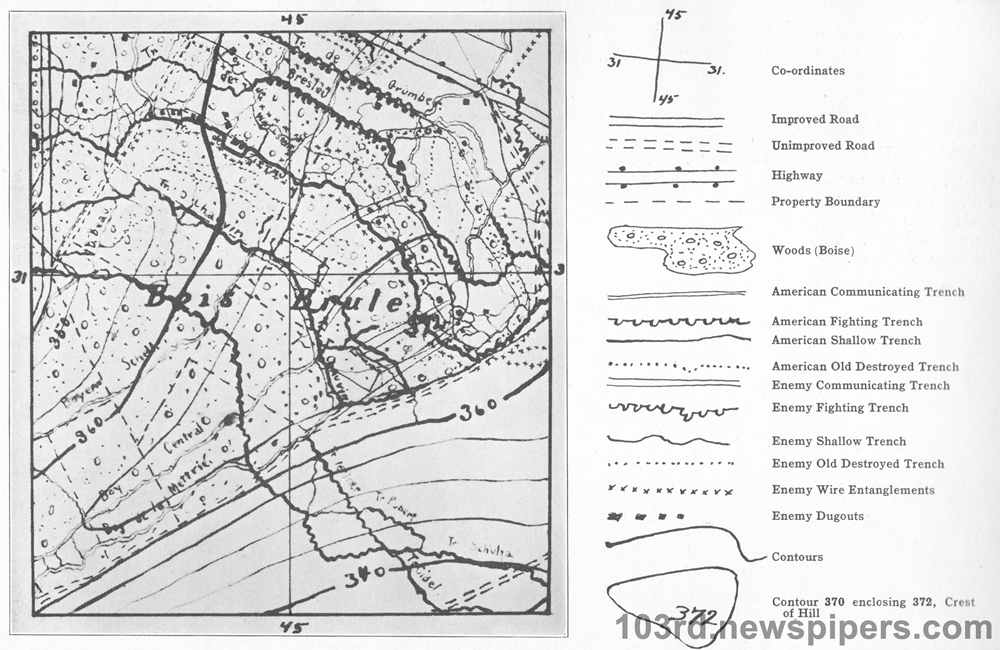
of the 26th Division of the U.S. Army
during World War I
 | The History of the 103rd Regiment of the 26th Division of the U.S. Army during World War I |
| Table of Contents | ||
The following memorandum is also of interest:
Headquarters, 3rd B’n.,
103rd U. S. Infantry, June 24, ’18.
JI/Icmomndrwr. to Company Cummamierss
1. The following translation is issued for your
information :
VIII Army,
General Stall, Q. G. 22 June ’18
2nnl Bureau, 9 o’clock.
BULLETIN No. 173
Extract
Interrogatien of three prisoners of the 36th Reg.
Landwehr (5th Div. Landwehr) captured st Xivroy
16 June 1918. _
Notes concerning the raid executed by the enemy
in the sector of Xivray 16 June 1918.
1. June 16th at about 3 o’ckyck the enemy
executed a raid in Lhe sector of Xivrsy.
It was completely checked. XojA1neri»
cans were taken prisoner.
2. Purpose: To disturb the adversary and tnkc
prisoners. j
3. Object·Lz»c: In reality there were two joint
raids —~ one executed by the 5th Div.
Landwelir on Xivray, the other on l\Iar—
voisin by the Sth Bavarian Reserve
Division. The objectives were those two
villages. After having cleaned up, the
above troops were to return to their own
line and Xivrny was to be held during
the day by a small garrison.
4. Rudd 0n Xivmy:
Effectives engaged:
300 men of the 36th Ldw. chosen from
all companies.
80 from 14th Storm Bln.
80 from 16th Pioneer Co. 5th Ldw.
30 from 2nd Co. Gd. Res. Pioneer
Reg. (Same projectors).
25 stretcher bearers—36th Ldw. Reg.
25 agents of liaison.
12 ofhecrs (approx.)
Major von Mackensen Comdg. 3rd l%’n 36th Ldw. Reg. was in command.
5. Armamcnt: About 12 Home projectors (small model) and 12 M. G. Light
and heavy.
6. Preparation: Patrols had reeonnoitered and found empty the trenches in
front of Xivray; one had cut our Wire on June 9th. Three rehearsals,
on the 12th, 13th and 14th Juno had been held on the drill ground near
the pond of Grand Montfaneon with the enemy position represented.
In the course of the last rehearsal an attempt was made by a system
of artificial smoke to mask the retreat at the close of the operation.
7. Plan: Three columns of :1ttaek—One the most important, containing
all the detaehments of thc Storm B’n, the greater part of the pioneers
and two groups of infantry was to attack the village from the west. Another,
mostly 36th Ldw., passing the village f`rom the west was to attack the village
from the south, The third, mostly 36th Lclw., route unknown was to attack
the village from the east. These three columns were to protect themselves from
the south and southwest by small flank guards. The columns were to place
themselves 500 metres from Xivray and only after the artillery had opened fire
on the village and its environs. After 10 minutes of artillery preparation, the
assault and mopping up; 45 minutes later the detachment was to return to
their lines, less 50 men and 1 oH·lce1· and 3 machine guns which were to remain in
Xivray until night. Liaison was to be maintained by telephone (Field lines)
optical signals and runners. (No wireless remarked.)
8. Artillery: 50 batteries of reinforcements (see
Nom below) north el` l\»lontsee; two long
range cannon t525—352 and 515—360).
9. Execution: The troops, quartered at Czieres
were transported in trueks along the Ro·
man Road to the ford of the llontsee-
Buxerulles road where they nrrrved at
about rnid—night. From there they pro-
eeeded on foot following the path east of
R eehirhanois to Snlmislin ; from there they
went through the woocls to the various
points of departure. The columns de-
bouehed at 3 o’cloek; they were noticed
by the Americans who opened on them
with machine guns. This [ire arrested
their progress at the edge of the village
only in part of one nolunm penetrating.
I0. I.0sx˘»x: The losses due to machine gun fire
were numerous. At the west end of
Xivray alone the prisoners sa\v·a doaen
dead, including the officer commanding
the detachment of the Storm B’n and 5
or G wounded. 4 _
Thirteen prisoners remain in our hands.
Nom: Cf. supra. This number ol batteries
probably exaggoratecl; only 15 were ob-
served.
Per Order of Major Soprrmnn,
\\'ALno Suvrnvay,
1sl Z/teal., Acting Adjutant.
 For this attack the enemy had made serious
preparations—he used pieked troops, moved his
artillery, and did everything which usually makes
for a sue·essi`ul raid, but he failed absolutely. Our
troops were outnumbered from three to five to one
and yet they heldi and what is more took
prisoners.
It was A real tryout of xvhatserl of stuff 103rd men
were made of. Company I, Lieut. Roger \Vill.ia.ms,
now captain, upon whom the brunt of the attack
fell, showed its worth as did also Company It. In
addition to the infantry attack against Xivray there
was a terriiie bombardment of back areas, more
especially of thu villages immediately in rca1·—Rambuc0u1·i, Boucunvillc, Raulc-
court. This was a day when men showed their worth— officers and men alike
—-Lieutenant Williams was everywhere encouraging his men. Lieutenant
Deane, now captain and in the Army of Occupation, not satisfied with the enemy
being driven back, with a small party of vo1un€eei·s—Licutcnant Pickering,
Sergeant Ernest Sullivan, Tommie Bums, Emmet Sloane, Alfred Le Page,
Anthony Simmons — went over in pursuit, rescued the only American who had
fallen into the cnemy’s hands, brought him back [along with some Bochcs, and
thus kept the slaic clean. For this was the only operation against any unit
For this attack the enemy had made serious
preparations—he used pieked troops, moved his
artillery, and did everything which usually makes
for a sue·essi`ul raid, but he failed absolutely. Our
troops were outnumbered from three to five to one
and yet they heldi and what is more took
prisoners.
It was A real tryout of xvhatserl of stuff 103rd men
were made of. Company I, Lieut. Roger \Vill.ia.ms,
now captain, upon whom the brunt of the attack
fell, showed its worth as did also Company It. In
addition to the infantry attack against Xivray there
was a terriiie bombardment of back areas, more
especially of thu villages immediately in rca1·—Rambuc0u1·i, Boucunvillc, Raulc-
court. This was a day when men showed their worth— officers and men alike
—-Lieutenant Williams was everywhere encouraging his men. Lieutenant
Deane, now captain and in the Army of Occupation, not satisfied with the enemy
being driven back, with a small party of vo1un€eei·s—Licutcnant Pickering,
Sergeant Ernest Sullivan, Tommie Bums, Emmet Sloane, Alfred Le Page,
Anthony Simmons — went over in pursuit, rescued the only American who had
fallen into the cnemy’s hands, brought him back [along with some Bochcs, and
thus kept the slaic clean. For this was the only operation against any unit
|
||
| Original Version of Page |